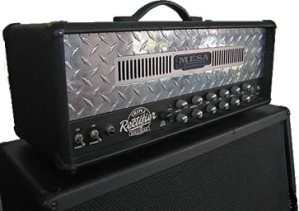|
www.learn-to-play-rock-guitar.com |
 |
|||
Mesa Boogie Amps
OK, I admit it. I'm a Mesa Boogie amps snob. Yeah, I’m biased, but it’s only ’cause once you’ve owned a Boogie, you can never go back. It’s kinda like trying to put toothpaste back in the tube… yeah, like that. Seriously, there’s something about the tone you get from Mesa Boogie amps that grabs you. I’ve tried out a number of amps, gigged with a Marshall stack, owned a few amplifiers in my day, and I keep coming back to Mesa Boogie. As I research more amplifiers, it seems every boutique (small, hand-made or custom) maker uses one or more Mesa Boogie amps as a benchmark when creating their products. They want to duplicate the classic Mesa tone in the rigs they’re building – you know what they say, "imitation is the sincerest form of flattery." The biggest challenge with Mesa amplifiers is price. You need to be pretty serious about your playing (or have a rich uncle) to justify buying a Mesa rig. I'm not saying they're not worth the money – I’m just saying they’re expensive! Depending on the model, you’ll easily lay down a minimum of a thousand bucks or more for a head or combo unit. You can get cabinets for less than a thousand bucks, but plan on investing a couple grand! Check out the rough price list here for an idea of what you’ll spend. These are US prices, so if you’re somewhere other than the United States, count on the cost being higher. If you’re looking to duplicate a sound from a favorite band, you can check to see if they use Mesa Boogie amps on their Artists Gallery page. Something important to remember is these guys choose Mesa amplifiers – Mesa Boogie doesn’t give gear to endorsees. The artists all buy their own rigs just like you and me. Mesa engineering doesn’t modify or customize amps for customers, either. So the following is for real – these guitarists use Mesa Boogie amps because this gear give them the tone and performance they want and expect. Just browsing the different bands represented, you have every genre covered from country to blues, punk to speed metal. To get a good feel for where the Mesa came from, it’s interesting that the whole thing started out with a Fender amp. Randall Smith (founder of Mesa Engineering) was goofing around with a Fender Princeton amp and beefed it up as a joke – but when people heard it, they all wanted one too. You can read about the history of Mesa Boogie amps and Randall Smith here on Mesa’s website. While you’re there, you can also get all the specs on the Mesa Boogie offerings, from the Dual Rectifier to the Stiletto. Check out reviews and testimonials, user manuals, artist videos and even a new free white paper on "How Amps Work". Good stuff! Or just head on over to Mesa’s home page to start at the beginning.
Back to the Guitar Amps page... Back to the Learning To Play Rock Guitar Homepage |
|
|||
|
div align="center">
Enjoy This Site?
Then why not use the button below, to add us to your favorite bookmarking service? |
||||
|
| Subscribe! | Contact Us | Link To Us | About Me | Sitemap | Disclosure | Privacy | Terms and Conditions |
|
||||
|
©Copyright 2007-2025 Sound Copywriting, LLC ~ All rights reserved. | ||||


